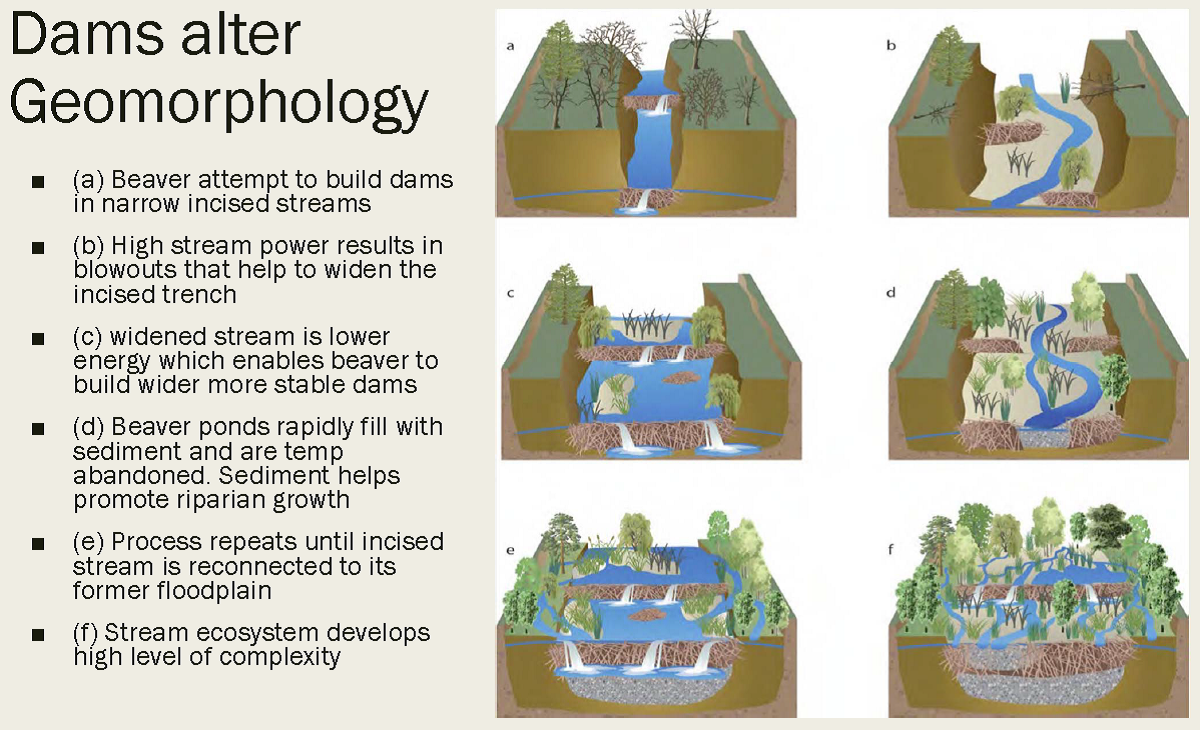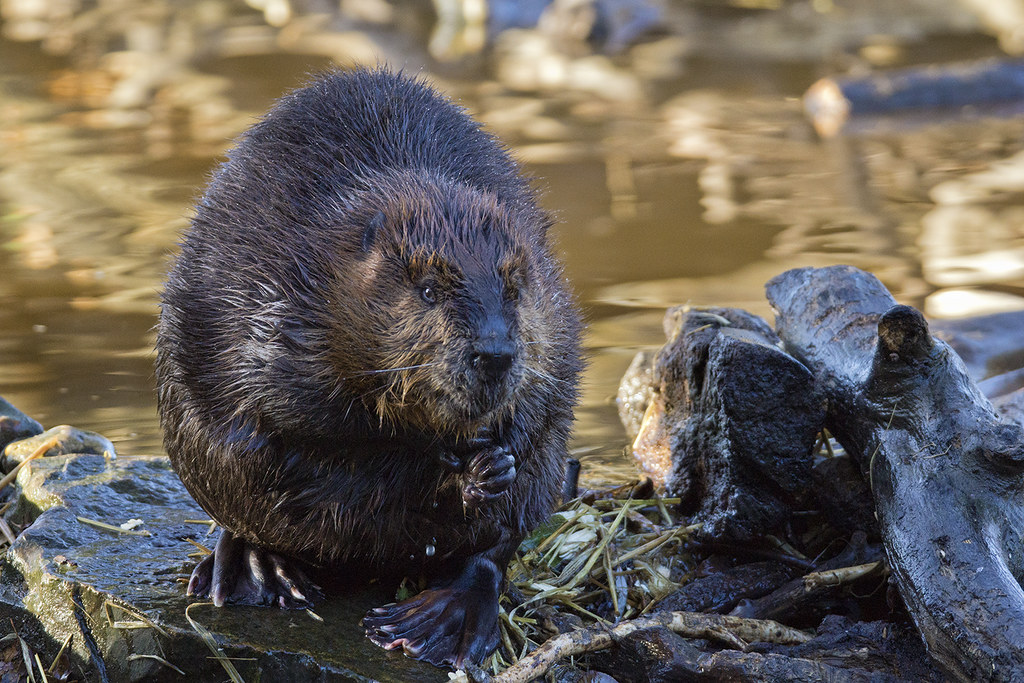Beaver are climate allies
Whether you live in an urban or rural area, restoring beaver’s role on public lands benefits us all via the water-rich, carbon storing habitat they create and maintain. As beaver-created wetlands, ponds, rising water tables and riparian vegetation increase, so does Oregon’s water security, its drought-preparedness, and its fish and wildlife habitat and connectivity. As habitat expands, so does the number of natural firebreaks – these zones of lush green and water serve as safety zones for wildlife and livestock during fire, and habitat post-fire (scroll down for more info). And they create conditions that improve salmon rearing habitat and quality throughout their range, as well as habitat for a variety of other fish, amphibians, invertebrates, plants and animals.
Supporting beavers is a nuanced and complex process. Bark’s beaver program approaches this work from three angles – education and outreach, science and data collection and habitat restoration:
- Through education and outreach, we aim to spread the message of beavers as vital keystone species worthy of protecting.
- We use science and data collection to understand more about where beavers and beaver modified habitat areas are within Mt Hood National Forest and the surrounding areas. We then share this data with scientists and land managers in order to be a resource for further beaver and beaver modified habitat protections. Much of this data will be used by the Oregon Department of Fish and Wildlife (ODFW) for future beaver reintroductions.
- We then do on-the-ground restoration work to enhance and create beaver habitat, making space for both reintroduction as well as natural beaver migrations into new areas.
Our beaver field days and campouts are crucial aspects of our beaver program because these excursions involve each of the three aspects of our beaver program. Each field day or campout is a great educational experience for those wanting to know more about beaver and beaver modified habitat; we often have volunteers that are very new to both these topics! Most of our field days consist of science and data collection where we go into a potential beaver habitat area and look for clues to current or past beaver use and potential appropriate habitat for beavers. For this, we use our Beaver Scorecard which was developed at Bark and now in use by ODFW as well. Check out this video (start at 48:30) for more details on data collection field days. Our field days during the fall and winter focus on habitat restoration. This can include willow planting, red osier dogwood planting, beaver dam analog (BDA) installation and tree tipping (tipping a tree into a stream to back the water up and create ponds). While beaver reintroduction is difficult and has a relatively low success rate, habitat restoration has the potential to help beavers immensely. We add to the amount of food beavers have access to which will allow them to stay in an area long enough to build lodges and dams and impact the habitat. We also increase water on the landscape via BDA installation and tree tipping, essentially pretending to be beavers to create more beaver habitat. After we improve the habitat, our hope is that beavers will move in naturally from surrounding stream reaches.
What is Beaver Modified Habitat?

What effects do these changes have?
- Erosion Control: Beaver ponds expand riparian (river & stream) vegetation by expanding water available for wetland and riparian plants. This increased vegetation along stream banks protects against erosion leading to better water quality for human use and better habitat for the salmon and steelhead in those streams.
- Improve stream temperatures: Currently ODEQ has thousands of stream miles listed as water quality impaired for temperature. The rise in water tables in beaver dominated meadows results in increased groundwater contributions to streams and ponds. When combined with deeper pond water depths, the result is a decrease in stream temperatures. This decrease can, in some cases, result in the stream or a segment of the stream being delisted.
- Habitat Creation: The ponds and meadows created by beavers enhance habitat for game species like ducks, deer & elk as well as improve migratory bird habitat. Expanded beaver ponds, wetlands, wet meadows and structurally complex and diverse riparian habitat across the state provide increased food sources, habitat resting areas, and rearing areas including snags for cavity nesting species. Benefits threatened, sensitive, and declining species like the Willow Flycatcher, Yellow Warbler, Song Sparrow and Yellow-breasted Chat.
- Salmon Recovery: The abundance of adromous fish, including salmon and steelhead, has been adversely affected by dams, overharvest, hatchery practices, habitat degradation, and will soon be affected by climate change. The late-run coho salmon Clackamas River along are considered the last remaining viable wild coho population in the Columbia Basin. The changes beavers make to their habitat can aid in salmon recovery in a number of ways:
- Improves Andromonous (migratory) Fish Habitat: Andromonous fish benefit from clean and clear water, deep pools, low water flows, and woody material in water. Beaver presence contributes to all of these factors.
- Improves rearing habitat: Rearing habitat has been identified as a hey limiting factor to salmonid species and beaver ponds have been identified as a key source of rearing habitat. As they provide, adequate food and a protective environment for salmon growth and survival
- Beaver’s effects on the environment are similar to the work that many agencies have done to restore riparian habitats and improve water quality and quantity. Beaver-created restoration is self-maintaining and self-enhancing as beavers continue to be around to repair dam breaches. Using this approach to restoration minimizes spending on the repetitive and reoccurring costs of maintaining restoration efforts so that dollars would be available to focus on species and restoration efforts in areas not influenced by beavers.

Want to know more?
Humans have been relocating beavers for a century. We are only now learning some of the effects.
Partnering with Beavers to Help Tackle the Climate Change Crisis
A Family Matter: Trapping and Relocating Beaver
ODFWs Beaver Habitat Action Plan
Beaver and fire by Dr. Emily Fairfax (45 seconds)
Methow valley project-Climate change by Sarah Koenigsberg (2:21 minutes)
Beaver’s role in the ecosystems and short history by Leanne Betosomosake Simpson. (< 5 minutes. Video collage by Heidi Perryman)
Beavers and Salmon: Beavers on Working Lands Featuring Landowners Betsy and Michael Stapleton (9:51 Minutes)
Beavers and Salmon: Featuring Fish Biologist and Restoration Specialist Steve Trask (6:41 Minutes)
Living with Beaver: Featuring Landowner Dave Powers (4:43 Minutes)
Living with Beaver: Creating A More Dependable Water Supply: Featuring U.S. Forest Service Hydrologist Kami Ellingson (5:41 Minutes)
Associated Files